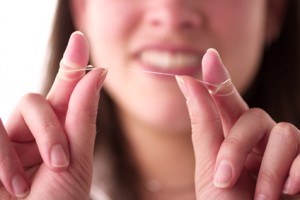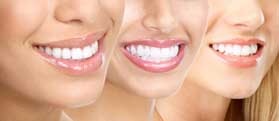 Picture this: You’re mere moments away from your regular dental visit, anticipating the question, “Have you been brushing and flossing regularly?” In an attempt to clean whatever might be lurking between your teeth before your hygienist or dentist catches you red-handed, you franticly brush and floss hours before your appointment. Once that dreaded questions comes, you give your answer, “Yes of course I do! All the time! I love flossing!,” but get the distinct feeling that they just don’t believe you.
So, how do we dentists know if you’ve been flossing regularly?
Being dentists, we can’t stress enough the importance of regular flossing in conjunction with brushing. Flossing is important to your gum and tooth health and when you don’t floss regularly, there are very apparent consequences.
The most obvious is inflammation between the teeth. When you don’t floss regularly, plaque, bacteria, and debris sit between the teeth causing inflammation. As a result, your gums start to look pink, puffy and inflammed and bleed easily.
The second give away is cavities forming between the teeth. Brushing your teeth, no matter how good and efficient you are at it, will not clean where the teeth meet. The only way to clean in that crucial spot is to floss. If you have any cavities or the beginning stages of cavities, it indicates that flossing is a weak point in your home care regimen.
Lastly, the biggest and most obvious sign that a patient is not flossing regularly is cuts or abrasions on the gums, indicating that the patient may have just flossed or isn’t doing it correctly or efficiently. If you aren’t careful and don’t know you’re way around your teeth and mouth, it will show.
The moral of the story is simple, make flossing a part of your daily regimen! The benefits to your oral health are tremendous.]]>
Picture this: You’re mere moments away from your regular dental visit, anticipating the question, “Have you been brushing and flossing regularly?” In an attempt to clean whatever might be lurking between your teeth before your hygienist or dentist catches you red-handed, you franticly brush and floss hours before your appointment. Once that dreaded questions comes, you give your answer, “Yes of course I do! All the time! I love flossing!,” but get the distinct feeling that they just don’t believe you.
So, how do we dentists know if you’ve been flossing regularly?
Being dentists, we can’t stress enough the importance of regular flossing in conjunction with brushing. Flossing is important to your gum and tooth health and when you don’t floss regularly, there are very apparent consequences.
The most obvious is inflammation between the teeth. When you don’t floss regularly, plaque, bacteria, and debris sit between the teeth causing inflammation. As a result, your gums start to look pink, puffy and inflammed and bleed easily.
The second give away is cavities forming between the teeth. Brushing your teeth, no matter how good and efficient you are at it, will not clean where the teeth meet. The only way to clean in that crucial spot is to floss. If you have any cavities or the beginning stages of cavities, it indicates that flossing is a weak point in your home care regimen.
Lastly, the biggest and most obvious sign that a patient is not flossing regularly is cuts or abrasions on the gums, indicating that the patient may have just flossed or isn’t doing it correctly or efficiently. If you aren’t careful and don’t know you’re way around your teeth and mouth, it will show.
The moral of the story is simple, make flossing a part of your daily regimen! The benefits to your oral health are tremendous.]]>
Posts

The tooth may be slightly traumatized.
When a filling is performed, it can be slightly irritating or traumatic to the nerve or pulp of the tooth. This can cause inflammation of the nerve leading to sensitivity in the tooth. This type of sensitivity is normal and usually subsides within 2 weeks.The bite may be high.
When you have a filling placed, the tooth is numb so it is often hard for the patient to tell if the bite is correct. If the bite is not balanced properly, it can focus too much biting force on one tooth, causing sensitivity. A slight adjustment will usually correct this.Another cavity nearby.
If you have multiple unfinished fillings or active periodontal disease in the area it is not always easy to tell which area is causing the sensitivity. This is because all the teeth are linked by branches of the same nerve. So it can be hard to tell which tooth it is. As a result, you may be feeling pain on one tooth, but it may be caused by a cavity or problem in another tooth.]]>  A few Secrets to having “No Cavities!” at your next dental exam…
A few Secrets to having “No Cavities!” at your next dental exam…
1. Floss!
Simply put, debris gets trapped in between your teeth, and the longer it sits there, the more problems it can cause. Clear the debris by flossing after meals and before you go to bed.2. Floss properly!
I see too many people flossing incorrectly, here is a video for proper flossing technique.3.Use Fluoride.
Fluoride strengthens the enamel on your teeth. Check your toothpaste and mouthrinse and make sure that it has fluoride in it.4. Use an electric toothbrush.
Use an electric tooth brush such as the Sonicare at least twice a day. It vibrates at a very high frequency clearing debris from your teeth. Most people brush for too short a period of time, many electric toothbrushes will count the 2 minutes of recommended brush time.5.Go for routine oral hygiene visits.
The average person should get a professional dental cleaning twice a year. There are many areas of the mouth that are missed with routine home care – a professional cleaning will get to these areas. If you follow these steps strictly you will improve your oral hygiene and increase the likelihood of hearing the words “No Cavities!” at your next exam!]]>Frangella Dental
Offering advanced techniques in Cosmetic and General Dentistry in New York City.
200 W. 57th Street, Suite 1405
New York, NY 10019
(212) 245-2888
care@drfrangella.com
